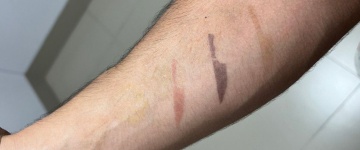Why do permanent makeup pigments turn red?
An undeniable fact: black iron oxide turns red.
Some believe that the reddening of the black pigment, after a certain period of wear in permanent makeup, will positively affect the healed result, i.e., "warm it up."
There's logic in this, but let's delve deeper:
Black iron oxide pigment turns red. In the world of permanent makeup, everyone is taught the complex term—valence change. Electrons moving back and forth—and there you have it, redness. But no one really understands what's happening and what the term even means.
Is the redness of the pigment color rust?
Jokes aside, let's state a simple fact: black iron oxide rusts.
Some are hoping that the black iron oxide pigment in their inks will rust and, as a result, their clients will have beautifully healed brows.
And if there was logic before, at this point it shatters to pieces because the valence change of black iron oxide is a problem for the producers of this pigment. They've spent years addressing this problem with encapsulation, polymeric structures, and other complex solutions. To some extent, they have solved it.
Has modern pigment production solved the problem?
Today's black iron oxide is metabolized by the body faster than it can rust and make your clients' brows redder.
So, there's no advantage to black iron oxide over Carbon Black due to valence change. Both pigments today are black and do not change color.
Of course, that's if the inks are compounded at the correct concentrations. If there's an excessive amount of black, the brows will still be gray, regardless of whether carbon black or black iron oxide was used in the ink production.
Examples of remaining tattoo pigment color in the photo
But black iron oxide is indeed removed through a red stage, and here's an example:

1. The healed result in mono colors, top to bottom: red iron oxide, black iron oxide, and yellow iron oxide.
2. Immediately after removal.
3. The healed result after one laser removal session.
It's evident that black iron oxide, unlike Carbon Black, doesn't lighten upon removal but simply changes its color.
So, does this take you back to 2009 and the days of Aqua inks?





